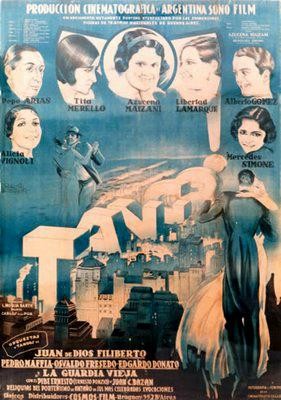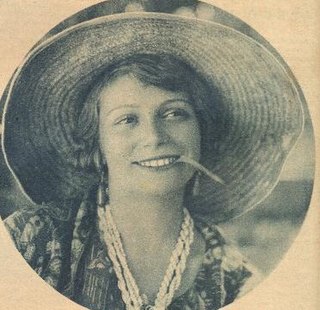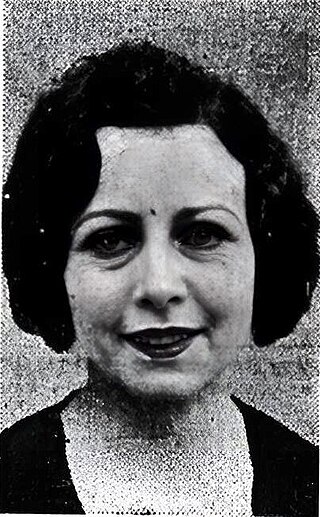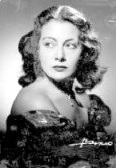
Carmen Olmedo (1909-1985) was a Peruvian actress, dancer, songwriter and vedette who made a career in Argentina, Chile and Spain.

Carmen Olmedo (1909-1985) was a Peruvian actress, dancer, songwriter and vedette who made a career in Argentina, Chile and Spain.
Carmen Olmedo was born in Lima, Peru, 1909. She grew up in an artistic home. Her parents was the Spanish bullfighter, Antonio Olmedo "Valentín", and the singer, Carmen Jaurequizar.
Olmedo reigned on the stages of Argentine theaters as a vedette in the early decades of the 20th century. She worked in numerous musical shows at the Esmeralda Theater (now Maipo Theater) during the 1920s. [1] She formed companies with leading Argentine figures such as Pepe Arias, Totón Podestá, and Tito Lusiardo. [2] In the 1940s, she traveled to Chile to work with other Peruvian personalities such as the stylist, Elsa del Mar, and the singer, Jesús Márquez. She worked at the Patio Andaluz with a company made up of Nicanos Molinare, the Spanish female singer, Carmencita de la Cruz, and the Bernardo Lacasia orchestra. In 1945, she moved to Spain where she performed at the Madrid Theater, the Zarzuela Theater and the Fuencarral Popular Theater. There, she worked with Celia Gámez, Maruja Boldoba, Virginia de Matos or Queta Claver. She formed a company with the Spanish comic actor, Pedrín Fernández. With her show, "Vales en Perú", lyrics by Luis Tejedor and Luis Muñoz Lorente, and music by Iso Fabra, she managed to please the public and remain working for a long time. She also became well known for her interviews with her puppy "Lulú" whom she used to take to her theatrical performances.
On March 28, 1930, when she was twenty-one years old, she married the Argentine comedian, Pepe Arias, but the relationship deteriorated due to the jealousy and bad character of Arias that precipitated the breakup of the couple. They finally divorced on July 31, 1934. [3] she Over time she married again, this time, with the banderillero Guillermo Martín. She lived with Martín until her death in Madrid, Spain, 1985. [4]

Laura Ana "Tita" Merello was an Argentine film actress, tango dancer and singer of the Golden Age of Argentine Cinema (1940–1960). In her six decades in Argentine entertainment, at the time of her death, she had filmed over thirty movies, premiered twenty plays, had nine television appearances, completed three radio series and had had countless appearances in print media. She was one of the singers who emerged in the 1920s along with Azucena Maizani, Libertad Lamarque, Ada Falcón, and Rosita Quiroga, who created the female voices of tango. She was primarily remembered for the songs "Se dice de mí" and "La milonga y yo".
Carmen Sánchez was a Spanish producer, dancer, and actress. She started her career as dancer and singer of zarzuela at very young age. At age 20, she finished working on copla or chotis and was featured in films between 1927 and 1928. She was a pioneer of silent films. She became a famous Spanish actress after the Spanish Civil War.

A vedette is the main female artist of a show derived from cabaret and its subcategories of revue, vaudeville, music hall or burlesque. The purpose of the vedette is to entertain and captivate the public. Vedettes are expected to sing, dance and act on stage. Particularly accomplished artistes are considered super vedettes or first vedettes. Vedettes often appear alongside groups of dancers, flashy and revealing costumes, magicians, comedians, jugglers, or even performing animals. Vedettes specializing in burlesque generally do striptease and may also perform nude on stage.

Carmen Lamas was a Spanish-born tango singer, and the first Spanish actress who made her career in Argentina. Lamas debuted in 1921 in a cast headed by his father, Miguel Lamas, Spanish actor and director. She was one of the first important figures of the Teatro Maipo, a vedette in the group known at that time as "Primera triple".

¡Tango! is a 1933 Argentine musical romance film, the first film to be made in Argentina using optical sound technology Many existing stars of the Argentine stage and radio appeared in the film, but its success was limited due to poor sound quality and weak acting. ¡Tango! established a formula that would be used by many subsequent tango films.

Azucena Maizani was an Argentine tango singer, composer and actress who was born in Buenos Aires on November 17, 1902, and died in the same city on January 15, 1970. She was discovered in 1920 by Francisco Canaro and quickly emerged as a major star. Her frequent appearances on stage and radio made her the female counterpart of Carlos Gardel although she did not enjoy as successful a film career as he did, appearing in a handful of films including Buenos Aires Sings (1947). During many years she gave performances dressed with men's suits or criollo cowboy attire for which she was known by the nickname "Funny-face Cowgirl", given to her by Libertad Lamarque in 1935.

Dora Gález (1903–2002) was a pioneering Argentine actress and vedette. She was one of the first stars of the Maipo Theater, and given the title of the "nightingale of the house". Other early co-stars with whom she worked were Carmen Lamas, Gloria Guzmán and Tita Merello. In 1924, she was in the cast of Roberto L. Cayol's Revue ¿Quién dijo miedo? which featured music by Arturo De Bassi along with Iris Marga, César Fiaschi, Carmen Lamas, and the debut performance of Tita Merello.

Gloria Guzmán (1902–1979) was a Spanish-born Argentine vedette and actress who performed in the early Argentine theater.

Aída Olivier was an Argentine dancer, vedette and actress of cinema and theatre.

María Padín was a Uruguayan film, radio, and theater actress and producer who had a successful career in Argentina.

Celia María Damestoi, better known as Lilian Valmar, was an Argentine actress and vedette.

Jorge Perez Evelyn is the stage name of Jorge Perez, an Argentine actor who rose to prominence in the 1980s as the first man-vedette in the famous Corrientes Avenue theatres of Buenos Aires. Until then, being a vedette was a role only reserved for those born women.
Raquel Daina Delas was a Spanish comedy actress and zarzuela performer during the first and second half of the 20th century in Spain and America. She was also a theatrical entrepreneur, vedette, actress and model.

Victoria Cuenca was an Argentine film actress during Argentina's Golden Age of cinema, as well as a theatre actress and a vedette.

Victoria Pinillos was a Spanish actress, dancer and vedette known in Argentina with her sister Laura.

Rosita Rodrigo was a Spanish actress, vedette, dancer and songwriter, highly successful in Spain, Mexico, Cuba, and Argentina. Among her most popular songs are the Valencian zarzuela, "Les barraques" and "Muñequita de trapo". She was also linked to politics, such as her relationship with Alfonso XIII.

Hortensia Arnaud was a pioneering Argentine dancer, vedette, and actress of film and stage. Arnaud made significant incursions during the heyday of cinematography and revue theater. Above all, she was a pioneer bataclana and premier dancer in Buenos Aires during the 1920s and 1930s.

Haydée Bozán was an Argentine actress, chorus girl, vedette, and businesswoman. She was the sister of actresses Sofía Bozán and Elena Bozán, and cousin of Olinda Bozán.

Anita Bobasso was an Argentine actress and tango singer who worked throughout the Americas and Europe, especially in Brazil, where she was well known, including works in radio broadcasting, theater, and cinema. The musical shows in which she participated used everything from typical costumes to informal and elegant dances. Bobasso also performed on a world tour with Libertad Lamarque and Azucena Maizani.

Hilda Dehil was an Argentine actress, singer, and dancer who worked throughout Brazil, Europe, and Argentina, her country, where she was very popular, including in radio soap operas and theaters. The musical shows in which she participated used everything from folkloric outfits to informal elegant dances before, later in life, she changed her acting style and formed part of the Vaudeville grace shows that are remarkable for being light in clothes, including the use of feathers and glitter.